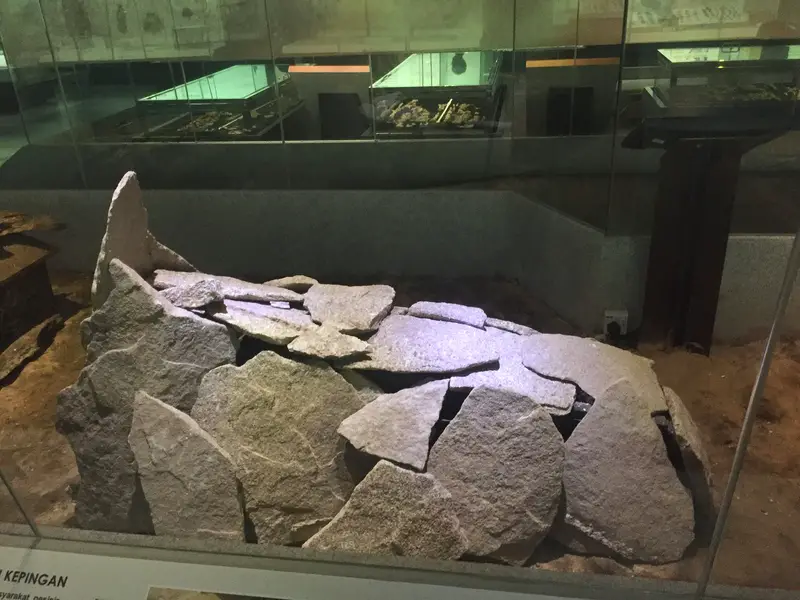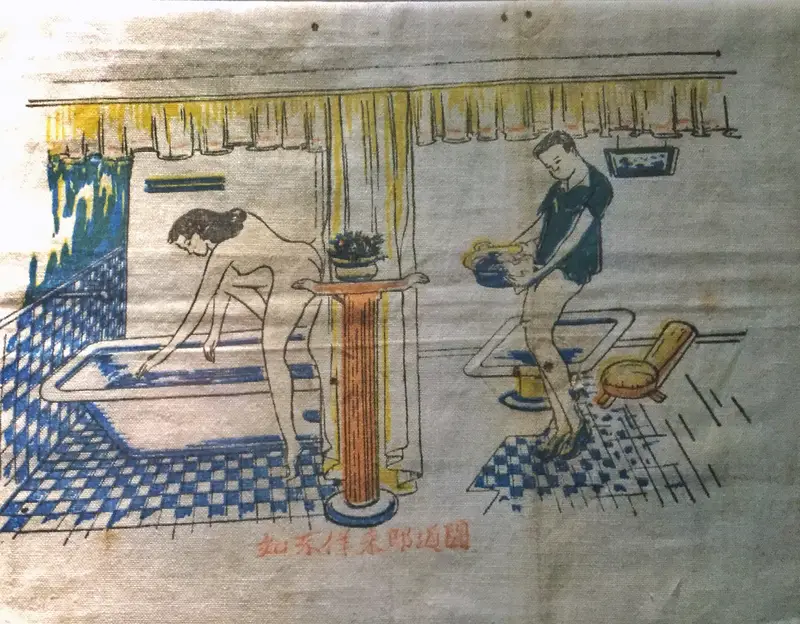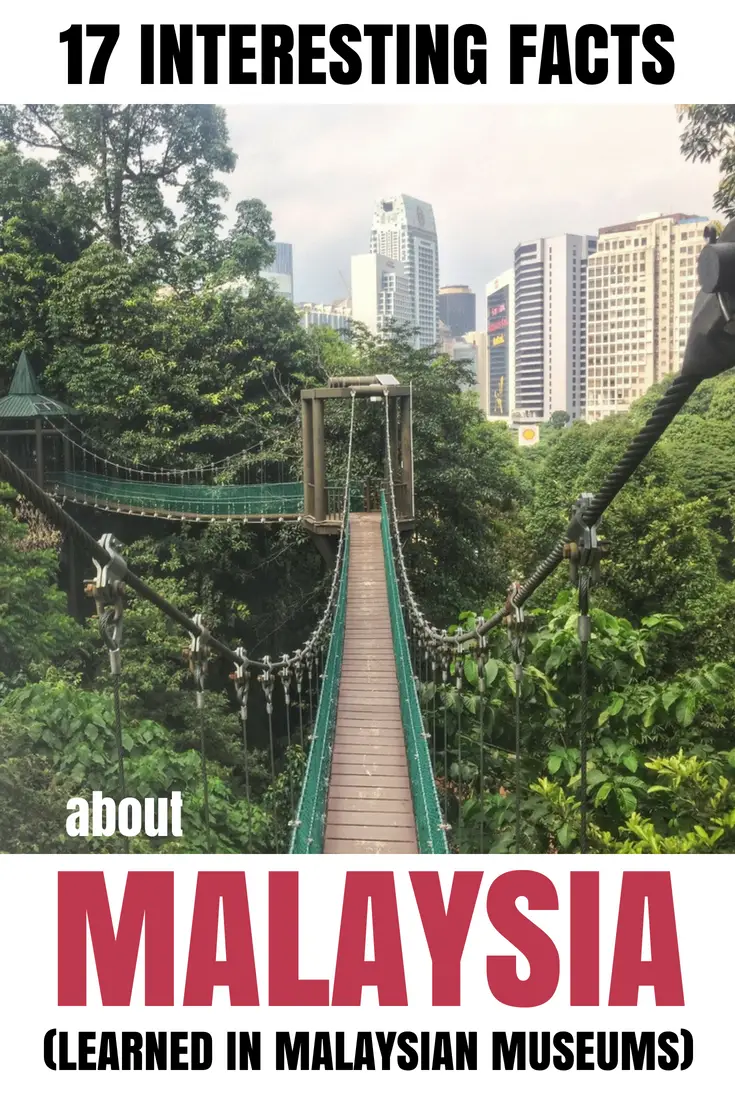If you were to think of places to find some facts about Malaysia from trustworthy sources, where would you go? (Wikipedia doesn’t count).
Museums! (plus lots of others)
It was while I was visiting some museums in KL that I was annoyed for never remembering any of the fun facts about Malaysia. That annoyance inspired this post.
I started to write down some things I was learning at different museums to compile this post. Here it is the result!
(there’s a key at the bottom telling you where each fact is from).
17 Interesting Facts About Malaysia
1. Stone slab burials were used in the Perak region between 300 BC and 1400 AD. The graves were created by placing stone slabs on top of the other, with the head section wider than the foot section. – NM
2. In Sabah, limestone caves were used as burial caves for log coffins made out of belian and merbau ~1000 years ago. For adults, graves were seven to twelve feet long and for children, four to six feet. Fast-forward to today and the practice is still followed in tribal communities in Ulu Kinabatangan and Ulu Segama in Lahad Datu. – NM
3. The first English school in Malaysia was Penang Free School in 1816. Accepting students from all races and religions, the local church and British East India company helped to fund the school, where students who graded well had great job opportunities. – NM
4. Pre-Independence Malay community education was free, with students helping teachers with their chores instead. Lessons were taught at the home of either the students or the religious teachers. – NM
5. During the state of emergency, communist terrorists would hack rubber trees as the countries economy was reliant on rubber production. In addition to hacking the trees, the plantation owners who wouldn’t cooperate were killed along with plantation workers. – NM
6. The Royal Malaysian Police (RMP) have the added task of contributing to the good name of the nation in sports at a national and international level. The focus on sports has led to the organisation being a place where lots of athletes have come from. – RMPM
7. During the Malayan Emergency, contraband items were regularly confiscated. This includes handkerchiefs that have somewhat normally prints on them. BUT if you fold them a specific way, the prints become pornographic. Interesting, someone should make these to sell on Amazon, you’d be rolling in the cash. – RMPM
8. In the late 1960’s the RMP introduced the Salleh System which uses the public to help prevent crime. It also enabled the police to be seen in a friendly manner, with a purpose of upholding the law in the community. After successful testing of the Salleh System proved successful the system was implemented nationwide. – RMPM
9. The Police Wives Association was formed in 1967 and still exists today with 80,000 members across the country. Known as PERKEP, the association promotes the interest and welfare of women. Membership criteria:
- The wives of RMP
- Daughters of RMP who are unmarried and over the age of 18
- The wives of police volunteer reserve unit, retired pesonnel, or those who have passed away.
- The women RMP who have retired.
– RMPM
10. In schools around Malaysia, children are given a Pocket Money Book. The programme started in 1998 and allows students to track and plan their daily expenses. This teaches them how to use limited resources effectively and efficiently. – BNMM
11. Sir Henry Wickham smuggled rubber seeds from Brazil into Malaysia in 1876. Fast forward to 1921 and the country needed to develop extensive rail and road infrastructure as the country was now producing half of the worlds rubber supply. – BNMM
12. The palm oil plant Elaeis guineensis was introduced to Malaysia from east Nigeria on 1961 and is now grown in massive plantations around the country. The pl fruit takes 5-6 months to mature with each plant produces fruit in large bunches weighing 40-50kg. – BNMM
13. Malaysia produced half of the worlds tin output in the early 20th century. That all changed in 1985 when the price of tin collapsed with Malaysia now producing less than 2% of the world’s production. – BNMM
14. Malaysia is one of the leaders in Islamic banking practices. With the industry based on Shariah principles, this means the following values should be upheld:
- Economic well being for all
- Fairness and justice for all
- Fair distribution of wealth
- Honesty and transparency
- Mutual cooperation, solidarity, and harmony
- Freedom to enter into contacts
This also means contracts with interest should be avoided as a Muslim should only profit through his own efforts. – BNMM
15. The 50RM note weighs 1.0g (same as three paper clips) and is the note with the highest circulation in the country. – BNMM
16. Bark is sometimes used to make clothing. The process to get there is:
- Tree chosen
- Cut down into logs of appropriate size
- Outter bark is shaven off
- The inner bark is hammered with a mallet until it is loosened enough to be peeled by hand
- The bark is soaked and after one more beating is pliable enough to make clothing
– NTM
17. The countries textiles industry can be traced back to the Neolithic era (2000-1500BC) and made from leaves and tree bark based on artifacts found. – NTM
Key:
NM = National Museum
RMPM = Royal Malaysian Police Museum
BNMM = Bank Negara Malaysia Museum and Art Gallery
NTM = National Textiles Museum
RELATED POSTS:
- 25+ PLACES TO VISIT IN KUALA LUMPUR
- MALAYSIA IN TWO WEEKS
- KAYAKING IN PUTRAJAYA
- WHERE TO GO AFTER KUALA LUMPUR
- IS KUALA LUMPUR WORTH VISITING?
THIS POST MAY CONTAIN AFFILIATE LINKS. PLEASE READ THE DISCLOSURE FOR MORE INFO.





Interesting that rubber and palm oil are not native crops. I know the palm oil industry, in particular, is causing environmental damage. Have to read more on Malaysian agriculture!
Hey Lee,
I need to read up on this too. My first trip to Borneo I was intrigued too see the devastating deforestation, but when you’re just on the bus you don’t see any of it road side which makes sense. Cheers, Jub